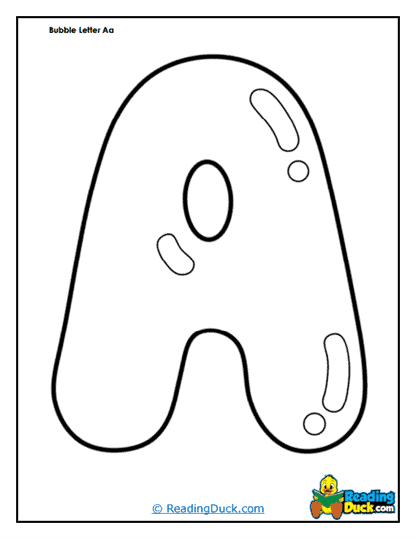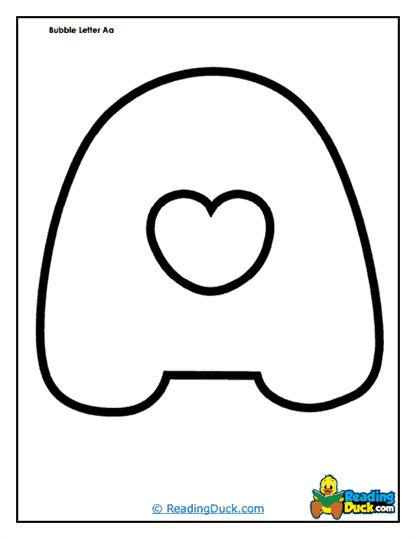Bubble Letter Aa Worksheets
About Our Bubble Letter Aa Worksheets
Bubble Letter Aa worksheets feature the uppercase and lowercase versions of the letter Aa drawn in an eye-catching, bold style. These letters are designed to stand out and invite children to engage with them creatively. Often paired with illustrations, tracing lines, or related words, these worksheets provide a structured way for children to interact with a single letter.
Educational Purposes
Improving Fine Motor Skills
Fine motor skills involve the small, precise movements of the fingers and hands that are essential for tasks such as writing, drawing, and manipulating objects. Engaging in activities like tracing the outlines of bubble letters or carefully coloring within the lines helps children develop greater control and precision in these movements. Over time, these exercises strengthen the small muscles in their hands, laying a foundation for more advanced skills like using scissors or tying shoelaces.
Enhancing Alphabet Familiarity
Familiarity with the alphabet is a cornerstone of early literacy, and focusing on one letter at a time allows children to deeply understand its unique shape and structure. By repeatedly encountering the letter Aa in various contexts-tracing, coloring, or identifying-it becomes more recognizable and easier to recall. Associating the letter with familiar words like "apple" or "ant" reinforces its phonetic sound and gives the learning activity a practical and engaging context, bridging the gap between recognition and application.
Boosting Creativity
Bubble Letter Aa worksheets are a wonderful platform for children to express their creativity in countless ways. They can experiment with different coloring techniques, create unique patterns within the letter, or even incorporate craft materials like glitter and stickers to personalize their designs. This freedom to explore fosters a sense of artistic confidence, allowing children to take ownership of their learning while also developing their imagination and creative problem-solving skills.
Encouraging Hand-Eye Coordination
Activities such as tracing the contours of bubble letters or coloring within them require careful synchronization of visual and physical movements. Children must closely observe the lines or shapes and guide their hands to match, a process that enhances their hand-eye coordination. This skill is crucial not just for academic tasks like writing but also for everyday activities such as dressing, eating with utensils, or playing sports.
Building Concentration and Focus
Completing a worksheet demands attention to detail, requiring children to concentrate on the task at hand and follow through to completion. These activities encourage patience as they work to stay within lines or carefully decorate the letter, teaching them to sustain focus over time. Such exercises help develop their ability to concentrate on more complex tasks in the future, both in and out of the classroom.
Are They Effective?
Bubble Letter Aa worksheets are highly effective tools for early childhood education due to their engaging and versatile nature. These worksheets appeal to children at various developmental stages, making them suitable for a wide range of learners. For younger children just beginning their literacy journey, bubble letter worksheets serve as an introduction to the letter's shape, helping them recognize the curves and lines that form the letter Aa. Tracing or coloring within the letter's outline reinforces its structure in their memory, while associating the letter with sounds like "ah" as in "apple" builds a foundational understanding of phonetics.
As children grow older, the same worksheets can be adapted to meet their evolving learning needs. What starts as a tool for basic recognition can transform into a medium for more complex tasks, such as creative writing or art projects. Older children may use bubble letters to design eye-catching titles for their stories or decorate them with intricate patterns, exploring their artistic abilities. This flexibility ensures that bubble letter worksheets remain engaging and relevant, encouraging learners to revisit the material with fresh perspectives as they advance.
Beyond their educational benefits, these worksheets also foster a sense of independence and accomplishment in children. Completing a worksheet-whether by accurately tracing the lines or finishing a creative decoration-provides a tangible goal that children can achieve on their own. This success boosts their confidence, instilling a sense of pride in their work. Such positive reinforcement is essential in early education, as it encourages children to approach new tasks with enthusiasm and persistence, setting a strong foundation for lifelong learning. By combining educational value with personal growth, bubble letter worksheets are a powerful tool for fostering both cognitive and emotional development.
Steps for Using These Worksheets
These worksheets can be an engaging and effective tool for a child's learning experience when used thoughtfully. These worksheets not only introduce letter recognition but also provide opportunities to enhance creativity and motor skills. To maximize their benefits, it's important to follow a structured approach tailored to the child's age and abilities. Below is a step-by-step guide to ensure these worksheets become a fun and meaningful part of any child's learning journey.
Step 1: Gather Materials
The first step is to prepare all the necessary materials for the activity. Start by printing out the Bubble Letter Aa worksheets. Depending on the child's preferences and age, gather a variety of art supplies such as crayons, markers, colored pencils, stickers, glitter, or even stamps. These materials help make the activity more engaging and encourage creativity. Also, set up a clean, flat surface where the child can comfortably work. A clutter-free and organized space ensures the child can focus entirely on the activity without unnecessary distractions.
Step 2: Explain the Activity
Before diving into the worksheet, it's essential to introduce the letter Aa in a way that captures the child's interest. Begin by showing the uppercase and lowercase forms of the letter, explaining their shape and sound. For example, you could say, “This is the letter A. A is for apple, ant, and airplane!” Connecting the letter to familiar words helps the child understand its use in everyday language. Explain the purpose of the worksheet-whether it's for tracing, coloring, or decorating-to give the child a sense of direction and excitement about what they'll be doing.
Step 3: Adjust for Age and Skill Level
To make the activity effective and enjoyable, adapt the worksheet to suit the child's age and developmental stage. Younger children may benefit from simple tasks that emphasize recognition and fine motor skills:
Coloring - Encourage them to fill the bubble letters with bright, fun colors of their choice. This helps improve grip and coordination while allowing for self-expression.
Tracing - Show them how to trace the outlines of the letters using their fingers, crayons, or markers. You can guide their hands if needed to build confidence.
Matching Words or Pictures - Pair the worksheet with flashcards or pictures of objects starting with the letter Aa, like apples, airplanes, or animals. This creates a meaningful connection between the letter and real-world items.
For older children, you can add complexity to the activity to make it more challenging and stimulating:
Adding Patterns - Suggest creating unique patterns, such as stripes, zigzags, or polka dots, inside the bubble letters. This fosters creativity and attention to detail.
Writing Practice - Ask them to write short words starting with Aa, such as “apple” or “ant,” inside or around the bubble letters. This reinforces their writing and spelling skills.
Storytelling or Drawing - Inspire them to use the letter Aa as a springboard for creativity. For example, they could draw a picture of an apple tree or write a short story about an adventurous ant.
Step 4: Make It Fun
Adding an element of fun ensures that the child stays engaged and excited about learning. Create small challenges, such as setting a goal to decorate three letters in a row or using only specific colors. This gamification aspect can motivate children to complete tasks with enthusiasm. Incorporate crafts like stickers, stamps, or glitter to make the worksheet visually appealing and tactilely engaging. For an interactive twist, turn the worksheet into a game. For instance, hide small letter Aas within a word search or on other pages and ask the child to find and circle them. These playful approaches make the activity feel less like work and more like an adventure.
By following these steps and tailoring the activity to the child's interests and skill level, you create a dynamic and enjoyable learning experience. Bubble Letter Aa worksheets are more than just an educational tool-they're an opportunity to foster creativity, build confidence, and make learning a fun and rewarding journey.









